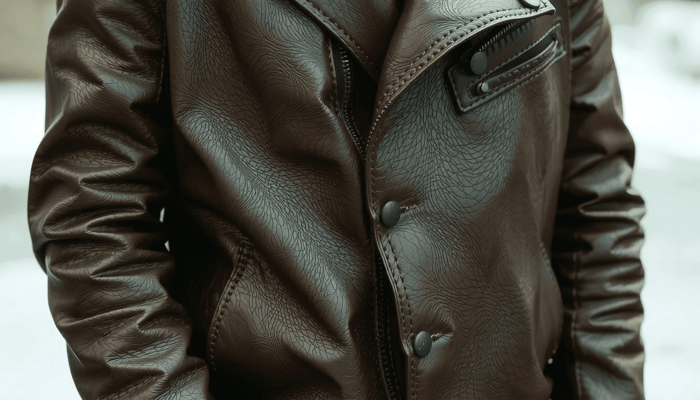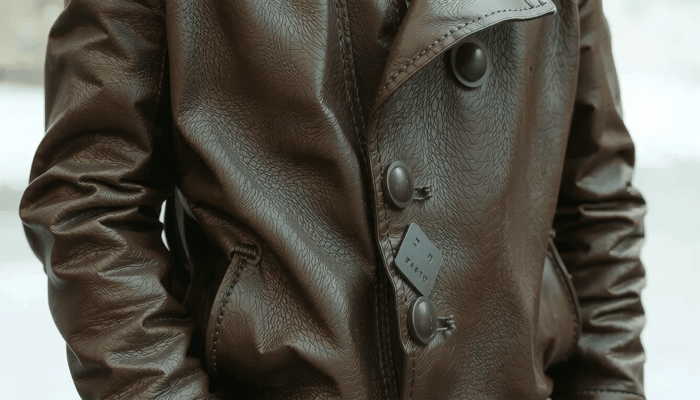Can Leather Jackets Get Wet? The Definitive Guide to Rain, Spills & Care
 Mr. Eton Yip | 32+ Year Garment Manufacturing Expert & Founder of Eton Garment
Garment Industry
Mr. Eton Yip | 32+ Year Garment Manufacturing Expert & Founder of Eton Garment
Garment Industry
July 17th, 2025
8 minute read
Table of Contents
Yes, leather jackets are susceptible to getting wet. Enjoying a little light rain will not be all that bad for your jacket. The water problem isn't the main worry. It's the consequences and your response to those consequences.

Unlike synthetic materials, leather is natural and porous, which makes it not waterproof. How moisture will affect leather indicates its shelf life.
This guide will explain how leather reacts to water. We will give you a quick drying plan. You'll find the reason why some kinds of leather are more water-resistant than others and learn the necessary care you should take.
Understanding the "Why"
Consider leather to be a sponge. Its surface is made of microscopic pores. When a leather jacket gets wet, water penetrates these pores. It combines with natural oils that keep leather supple and resilient.
When the water vaporizes, it doesn't do it alone. It also takes some of the oils needed for protection, so the leather is left without some of the properties that are basically essential. This is why a wet jacket feels rough and damaged to touch after it dries out.
The collagen fibers that make up leather's structure are primarily responsible for its properties. The result is that the fibers become stiff when they lack the protective oils. They are more susceptible to breaking when they are under pressure. Experts assert that leather is permeable and not waterproof. If not cared for properly, the absorption of water can lead to irreversible damage.
The Telltale Signs of Damage
Look for specific indications if you believe that your jacket was soaking wet. Swift action is crucial. Choosing to overlook those signs can result in problems that are permanent, for example, discoloration, stiffening, or shrinking.
Here are the signs to check:

- Water Stains or Spots: The surface of the leather develops dark circles or rings that stay even after the jacket dries completely.
- Stiffness and Brittleness: The jacket no longer feels luxuriously soft. It may be stiff when you're wearing it, and it may make crackling sounds when you move.
- Cracking: Tiny lines or big gulfs appear in leather that has dried out and may crack or bend. This strong damage is unrecoverable.
- Discoloration or Fading: The color of water doesn't strip the dye uniformly off the leather, so it gets discolored or dotted.
- Mold or Mildew: Humid jackets stored without sufficient ventilation set the stage for mildew. You might see spots and smell must.
Emergency Rescue: A Drying Guide
You were caught in a downpour. However, keep calm! Your actions in the next 24 hours will determine its fate. Execute this emergency plan to the letter.
The most common mistake is to use a hairdryer or place jackets next to heaters. Direct heat shrinks, warps, and cracks leather beyond repair. But by being patient, you can save your jacket.
- Blot, Don't Rub. Use a dry, clean, soft cloth immediately. Microfiber is great. Just dab the jackets surface carefully. Your goal is to absorb whatever water is on the surface. Rubbing the material will push the water further in and ruin the finish.
- Empty and Reshape. Clear out the contents of the pockets. Heavy stuff will stretch the leather. Crumple newspaper logs or paper towels as filling, helping the jacket stay in shape and absorbing moisture.
- Hang It Properly. Employ a wide, sturdy, padded, or wooden hanger. Thin metal hangers dig into wet shoulders and result in unpleasant permanent stretching and puckering. The right hanger provides the needed support while enabling the jacket to keep its natural shape.
- Air Dry Naturally. This step matters the most. Hang the jacket in a cool, dry room that has good airflow, thus keeping it away from direct heat. No sunlight, radiators, fireplaces, or heating vents. Let it dry slowly and naturally. This may take 24-48 hours depending on how wet it was.
- Recondition. The jacket will feel stiff once it is thoroughly dry. It was water-stripped of its natural oils. With a soft cloth, apply quality leather conditioner. It will restore your jacket's oils, add flexibility, and help against future damage.
Water Resistance by Type
Not all leathers are created equal, especially when it comes to water-related issues. Therefore, the first key to leather jacket care is to learn what type of material your jacket is made of. For instance, faux leather jackets cope with water better than real ones.

| Leather Type | Water Resistance | What Happens When Wet? | Best Care Tip |
|---|---|---|---|
| Full-Grain | High (Natural) | Lightweight rainwater can be repelled due to its fiber density but torrential rain can be soaked. | Regularly maintain the natural oil barrier so it stays strong and healthy. |
| Top-Grain | Moderate | Frequently, it features a pigmented finish, which gives a little protection. However, water can still be absorbed and lead to stains. | Annually reapply a good quality water protectant spray for the best results. |
| Suede/Nubuck | Very Low | Instantly dark stains appear on it due to moisture absorption and, even worse, the napped surface is not easily returned to its original condition. | Must be preemptively treated with a specialized suede & nubuck protector spray. |
| Faux Leather | Very High | It is almost 100% waterproof as it is made of polyurethane, which is a plastic material. Water simply beads on the outside. | Just wipe it dry. The main concern is water coming in through the seams where the stitching is done. |
Proactive Protection
To deal with wet leather effectively, you need to avoid the situation in the first place. Trying to make your jacket "waterproof" is a big mistake. It blocks the pores and prevents the leather from breathing. Instead, you should follow the path of "water-resistant".
Choose the Right Product
You have two choices: Wax or cream-based conditioners are nourishing and protective. Silicon-based sprays create a surface barrier. Sprays are more effective against rain; however, creams will feed the leather nutrients. It is your responsibility to apply protection. You can read more about How to Protect Your Leather Jacket From Water D.... Always do a test for new products in inconspicuous parts like inner cuffs. It is vital to ensure that they will not alter the color.

For durable or bespoke products, always ask the makers of the brand. To get quality gear, visit the site: Etongarment.
The Application Process
The application of water protection is easy and quick. Do this at least once every year, or after being completely soaked.
- Ensure that the jacket is clean and completely dry.
- Evenly apply the product over the whole surface using a soft cloth or spray at the recommended distance.
- Make sure to cover highwear areas first like the shoulders and seams.
- Buff off with a clean, dry cloth any residual product that is left behind.
- Hang it for several hours to allow it to dry or according to the directions on the product before use.
Conclusion: Wear With Confidence
So, can leather jackets get wet? Yes, but it won't hurt your favorite jacket at all. A little rain or the accidental spilling of drinks wouldn't do any lasting harm if you react quickly and correctly.
The golden rule is to stay cool. Never introduce heat. Always, make sure to condition it right. With preventive maintenance and a solid emergency response plan, you can wear your leather jacket in any weather with ease.
Frequently Asked Questions (FAQ)
1. Can you use a hairdryer to dry a leather jacket faster?
No, absolutely not. Direct heat from hairdryers is terrible for wet leather. It makes natural oils evaporate too fast, causing shrinking, warping, and permanent cracking. Always choose slow, natural air drying away from heat sources.
2. How often should I waterproof my leather jacket?
Apply water-resistant spray or conditioning cream once a year for regular wear. If you live somewhere rainy or your jacket got soaked, clean and recondition it after it dries completely.
3. Is rain bad for a brand new leather jacket?
Yes, rain damages new jackets just as much. Many new jackets have light factory finishes, but these don't guarantee water resistance. We strongly recommend treating new leather jackets with quality protector before they face unpredictable weather.
4. Can water stains be removed from leather?
It depends how bad they are. For light spots, gently rub the stain with a cloth slightly damp with distilled water. Feather it out and condition the entire panel to even the color. Deep, set stains may need specialized leather cleaner or professional help.
5. Does getting a leather jacket wet help break it in?
This is a popular but risky myth. Wearing a wet jacket until it dries can mold it to your body, but this severely strips leather of essential oils. Without immediate and thorough reconditioning, you risk stiffness and cracking. This is the opposite of a well-broken-in feel. Much safer break-in methods exist.
Related Articles
The Ultimate Guide: How to Wear a Denim Jacket for Guys in Any Season
10 minute read
July 17th, 2025
The denim jacket is more than just clothing. It's a style icon for men. For decades, it has been... more »
How to Get Off the Screen Printing from a Nylon Jacket: A True (and Absolute) Manual
10 minute read
July 17th, 2025
You are facing a dilemma of dealing with a nylon jacket that has screen printing and has your attention... more »
The Ultimate Guide: Washing a Down Jacket So It Will Serve You for a Long Time
12 minute read
July 17th, 2025
Down jackets made of good and quality materials are a great investment. You can wear it all day and feel... more »
What Is a Sports Jacket? The Ultimate Guide to This Wardrobe Essential
10 minute read
July 17th, 2025
A sports jacket is a tailored jacket you wear on its own. It doesn't come with matching pants.... more »
Are Heated Jackets Safe? The Definitive Guide to Technology, Risks, and Safe Usage
10 minute read
July 18th, 2025
Let's get straight to the point. Yes, heated jackets are very safe when you buy them from trusted... more »

